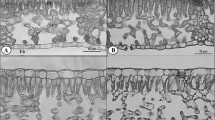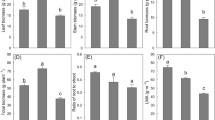Abstract
Light is one of the main factors of physical environment and it controls plant growth and development by interfering with photosynthesis, especially concerning CO2 assimilation. Photosynthetic characteristics and growth of C3 epiphytic orchids Miltonia flavescens and Miltonia spectabilis var. moreliana were analyzed under four radiation regimens (25, 50 and 75 % of global radiation and full sunlight). Anatomical characterizations were performed on plants grown at 25 % shade. Artificial shading was obtained using different shading nylon nets. The highest values of light-saturated photosynthetic, dark respiration, net photosynthetic and leaf transpiration rates, stomatal conductance and intercellular to atmospheric CO2 concentration ratio were observed at full sunlight and 25 % shade. Moreover, both species allocated greater amount of leaf dry weight in those treatments. On the other hand, it was observed a greater investment in pseudobulb biomass in more shaded conditions (50 and 75 %), corroborating with the highest values of intrinsic water-use efficiency observed in those treatments. It was found a significant effect of shading on leaf area and specific leaf area. The anatomical features reflected strategies to save water. The phenotypic plasticity and principal component analysis suggested that the physiological traits were more responsive to light levels than the morphological traits. The results indicate that those species appear to be adapted to high irradiances conditions and are capable of adjusting, via morphophysiological changes, to light availability.




Similar content being viewed by others
References
Aranda I, Robson TM, Rodríguez-Calcerrada J, Valladares F (2008) Limited capacity to cope with excessive light in the open and with seasonal drought in the shade in Mediterranean Ilex aquifolium populations. Trees 22:375–384
Benzing DH (1987) Vascular epiphytism: taxonomic participation and diversity. Ann Mo Bot Gard 74:183–204
Benzing DH, Friedman WE, Peterson G, Renfrew A (1983) Shootless velamentous roots and pre-eminence of Orchidaceae in the epiphytic biotope. Am J Bot 70:121–133
Björkman O (1981) Responses to different quantum flux densities. In: Lange L, Nobel PS, Osmond CB, Ziegler H (eds) Encyclopedia of plant physiology. Springer, Berlin, pp 57–107
Boardman NK (1977) Comparative photosynthesis of sun and shade plants. Annu Rev Plant Physiol 28:355–377
Bonates LCM (1993) Ecophysiological studies of Orchidaceae in Amazonia. II—ecology of leaf anatomy of species with CAM metabolism in a Central Amazonian white sand campina. Acta Amazon 23:315–348
Campos MA, Uchida T (2002) Influence of shade on the growth of seedlings of three Amazon species. Pesq Agropec Bras 37:281–288
Claussen JW (1996) Acclimation abilities of three tropical rainforest seedlings to an increase in light intensity. Forest Ecol Manag 80:245–255
Cooper CS (1966) Response of birdsfoot trefoil and alfafa to various levels of shade. Crop Sci 6:63–66
Cooper CS, Qualls M (1967) Morphology and chlorophyll concentration of shade and sun leaves of two legumes. Crop Sci 7:672–673
Dickison WC (2000) Integrative plant anatomy. Harcourt Academic Press, San Diego
Evans JR, Poorter H (2001) Photosynthetic acclimation of plants to growth irradiance: the relative importance of specific leaf area and nitrogen in maximizing carbon gain. Plant Cell Environ 24:755–767
Fahn A (1990) Plant anatomy. Blutterworth-Heinemann, Oxford
Gravendeel B, Smithson A, Slik FJW, Schuiteman A (2004) Epiphytism and pollinator specialization: drivers for orchid diversity? Philos Trans R Soc Lond B Biol Sci 359:1523–1535
He J, Khoo GH, Hew CS (1998) Susceptibility of CAM Dendrobium leaves and flowers to high light and high temperature under natural tropical conditions. Environ Exp Bot 40:255–264
Helbsing S, Riederer M, Zotz G (2000) Cuticles of vascular epiphytes, efficient barriers for water loss after stomatal closure? Ann Bot 86:765–769
Hew CS, Yong JWH (1997) The physiology of tropical orchids in relation to the industry. World Scientific, Singapore
Hikosaka K, Terashima I (1995) A model of the acclimation of photosynthesis in the leaves of C3 plants to sun and shade with respect to nitrogen use. Plant Cell Environ 18:605–618
Hunt R, Causton DR, Shipley B, Askew AP (2002) A modern tool for classical plant growth analysis. Ann Bot 90:485–488
Konow EA, Wang Y-T (2001) Irradiance levels affect in vitro and greenhouse growth, flowering, and photosynthetic behavior of a hybrid Phalaenopsis orchid. J Am Soc Hort Sci 126:531–536
Kraus JE, Arduin M (1997) Manual básico de métodos em morfologia vegetal. EDUR, Seropédica
Lin M-J, Hsu B-D (2004) Photosynthetic plasticity of Phalaenopsis in response to different light environments. J Plant Physiol 161:1259–1268
Lorenzo N, Mantuano DG, Mantovani A (2010) Comparative leaf ecophysiology and anatomy of seedlings, young and adult individuals of the epiphytic aroid Anthurium scandens (Aubl.) Engl. Environ Exp Bot 68:314–322
Morgano MA, Queiroz SCN, Ferreira MMC (1999) Application of exploratory analysis to the differentiation of vegetables. Braz J Food Technol 2:73–79
Niinemets Ü (2007) Photosynthesis and resource distribution through plant canopies. Plant Cell Environ 30:1052–1071
Niinemets Ü, Valladares F (2004) Photosynthetic acclimation to simultaneous and interacting environmental stresses along natural light gradients: optimality and constraints. Plant Biol 6:254–268
Nowak EJ, Martin CE (1997) Physiological and anatomical responses to water deficits in the CAM epiphyte Tillandsia ionantha (Bromeliaceae). Int J Plant Sci 158:818–826
Oliveira V, Sajo MG (1999) Leaf anatomy of epiphyte species of Orchidaceae. Rev Bras Bot 22:365–374
Oliveira V, Sajo MG (2001) Stem anatomy of nine Orchidaceae species. Acta Bot Bras 15:177–188
Pabst GF, Dungs F (1975) Orchidaceae Brasilienses. Part I Kurt Schmersow, Hildesheim
Pastenes C, Santa-Maria E, Infante R, Franck N (2003) Domestication of the Chilean guava (Ugni molinae Turcz.), a forest understorey shrub, must consider light intensity. Sci Hort 98:71–84
Popma J, Bongers F, Sauss FT, Lee RY (1992) Gap-dependence and leaf characteristics of trees in a tropical lowland rain forest in Mexico. Oikos 63:207–214
Salatino A, Montenegro G, Salatino ML (1986) Scanning electron microscopy of leaf surfaces of woody species of cerrado. Rev Bras Bot 9:117–124
Scalon SPQ, Filho HS, Rigoni MR, Veraldo F (2001) Germination and growth of Eugenia uniflora L. seedlings under shade conditions. Rev Bras Frutic 23:652–655
Valladares F, Wright SJ, Lasso E, Kitajima K, Pearcy RW (2000) Plastic phenotypic response to light of 16 congeneric shrubs from a Panamanian rainforest. Ecology 81:1925–1936
Valladares F, Sanchez-Gomez D, Zavala MA (2006) Quantitative estimation of phenotypic plasticity: bridging the gap between the evolutionary concept and its ecological applications. J Ecol 94:1103–1116
Webb WL, Newton M, Starr D (1974) Carbon dioxide exchange of Alnus rubra: a mathematical model. Oecologia 17:281–291
Zhang SR, Ma KP, Chen LZ (2003) Response of photosynthetic plasticity of Paeonia suffruticosa to changed light environments. Environ Exp Bot 49:121–133
Zhang S-B, Hu H, Xu K, Li Z-R, Yang Y-P (2007) Flexible and reversible responses to different irradiance levels during photosynthetic acclimation of Cypripedium guttatum. J Plant Physiol 164:611–620
Zimmerman JK (1990) Role of pseudobulbs in growth and flowering of Catasetum viridiflavum (Orchidaceae). Am J Bot 77:533–542
Acknowledgments
Thanks are due to FAPESB (Foundation for Research Support of the State of Bahia) for the scholarships granted to M.V. Pires and P.P. Abreu, and CNPq (Brazilian Council for Advancement of Science and Technology) for the scholarships awarded to A-A.F. Almeida and financial support. M.V. Pires thanks Prof. D.A. Cunha for the support on Principal Components Analysis.
Conflict of interest
The authors state that they have no conflict of interest.
Author information
Authors and Affiliations
Corresponding author
Additional information
Communicated by B. Zheng.
Rights and permissions
About this article
Cite this article
Pires, M.V., de Almeida, AA.F., Abreu, P.P. et al. Does shading explain variation in morphophysiological traits of tropical epiphytic orchids grown in artificial conditions?. Acta Physiol Plant 34, 2155–2164 (2012). https://doi.org/10.1007/s11738-012-1016-9
Received:
Revised:
Accepted:
Published:
Issue Date:
DOI: https://doi.org/10.1007/s11738-012-1016-9




